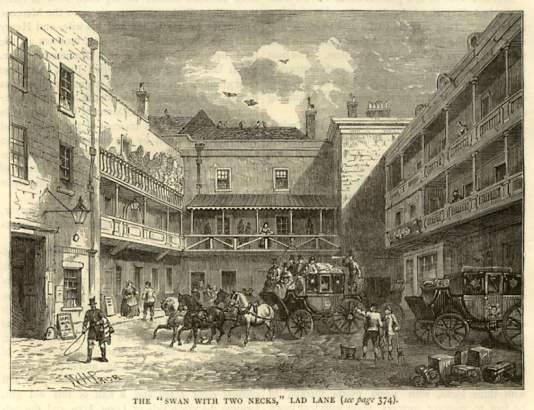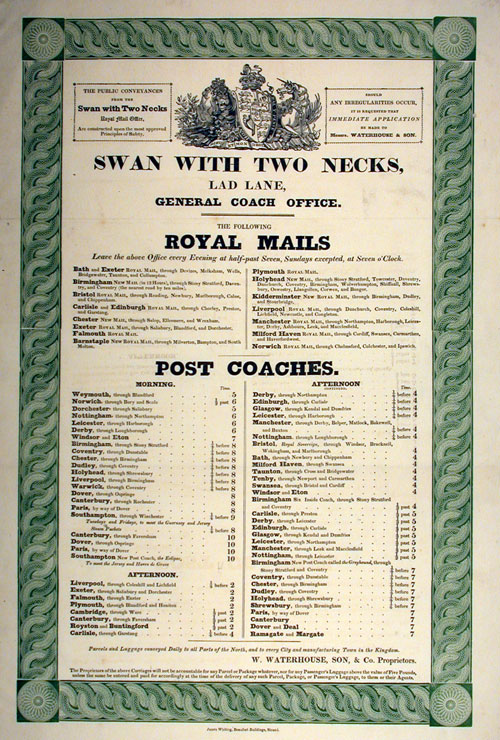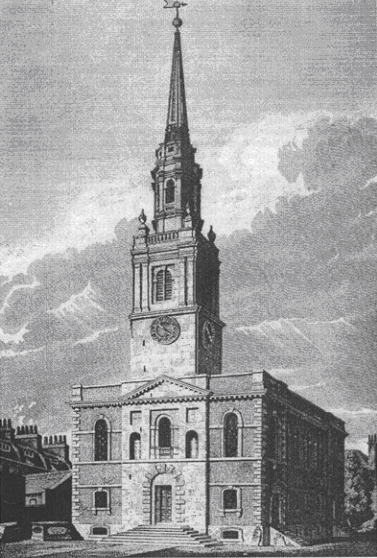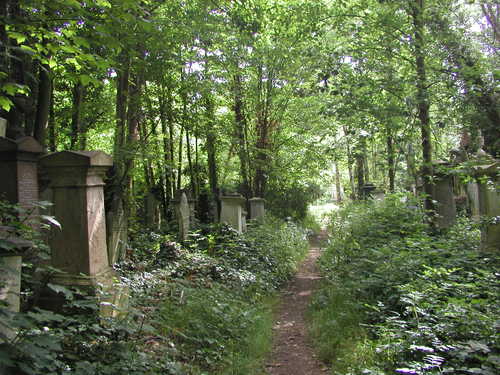Charles Warland goes to London
Dorset to London
Charles must have left his home in Wimborne Minster, Dorset and travelled to London around 1829 when he was 21. At that time the Dorset economy was severely depressed dues to changes in the Corn Laws and increasing land enclosures, prospects in the rural communities were not good. In 1829 travelling to London would have been a major undertaking. It was possible by horse drawn coach to start the journey at five in the morning and arrive in London the same day, essentially non-stop for eleven hours except for changes of the horse team. The stagecoach was pulled by four or six horses and travelled at a steady five miles per hour (eight kilometres per hour). Inside the coach were two cushioned seats, taking three persons on each side. Outside passengers travelled at a cheaper rate, either in the luggage basket which was slung between the back wheels, or on the roof, clinging to the baggage. This was the only viable way to travel then since the railway had yet to be built. The journey from Dorchester to London would have cost 10 shillings outside or one pound inside the coach. Since 10 shillings was a weeks wages at that time, Charles likely travelled outside.


For Charles, arriving in London after growing up in Dorset must have been a major shock. After passing the various villages in what is now suburban London he would have arrived at the coaching stop. This could well have been The Swan With Two Necks in Lad Lane, Cheapside in London which received much of the coaching traffic. Charles seems to have stayed in that area for most of his London life. The Old Bailey criminal court shows a proceeding in 1830 involving the theft of a pair of shoes worth five shillings from the innkeeper of the Magpie Inn, 107 Wood Street in Cheapside. Mr. Greeves said that he was keeping the shoes which belonged to Charles Warland. Charles said he had given them to the prisoner to be cleaned. It seems reasonable to conclude that Charles was staying at the Magpie in 1830.

In 1835 Charles married Mary Jane Ortell of Holborn, London. The marriage took place by license and not by the usual process of ‘reading the banns’ in the home parishes of both parties. The purpose of banns is to enable anyone to raise any legal impediment to it, so as to prevent marriages that are legally invalid and was almost. Charles being from Dorset made this extremely difficult and we can assume that the couple applied to the faculty office of the parish they were marrying in for the license. They would have paid a fee for this, perhaps as much as one pound. The couple subsequently married in St. James Clerkenwell.
In 1841 there is census evidence of Charles working as a porter at The Swan. He appears in the census along with Thomas Dewey, the Inn keeper at that time. But there is a second census entry showing Charles living with Mary stating that he was a clerk. Maybe he had two jobs to make ends meet.
In 1846 Charlotte Sarah, the last of their six children was born and Charles was working as a clerk. This was a solid and respectable job in Victorian times and would have enabled Charles to support his family and live a modest lifestyle. In 1851 they still lived in the same area and Charles was still a clerk, now working for the railways.
Charles died of typhoid fever in 1856, a year after Mary. They are both buried in separate graves in Abney Park cemetry, Stoke Newington.
